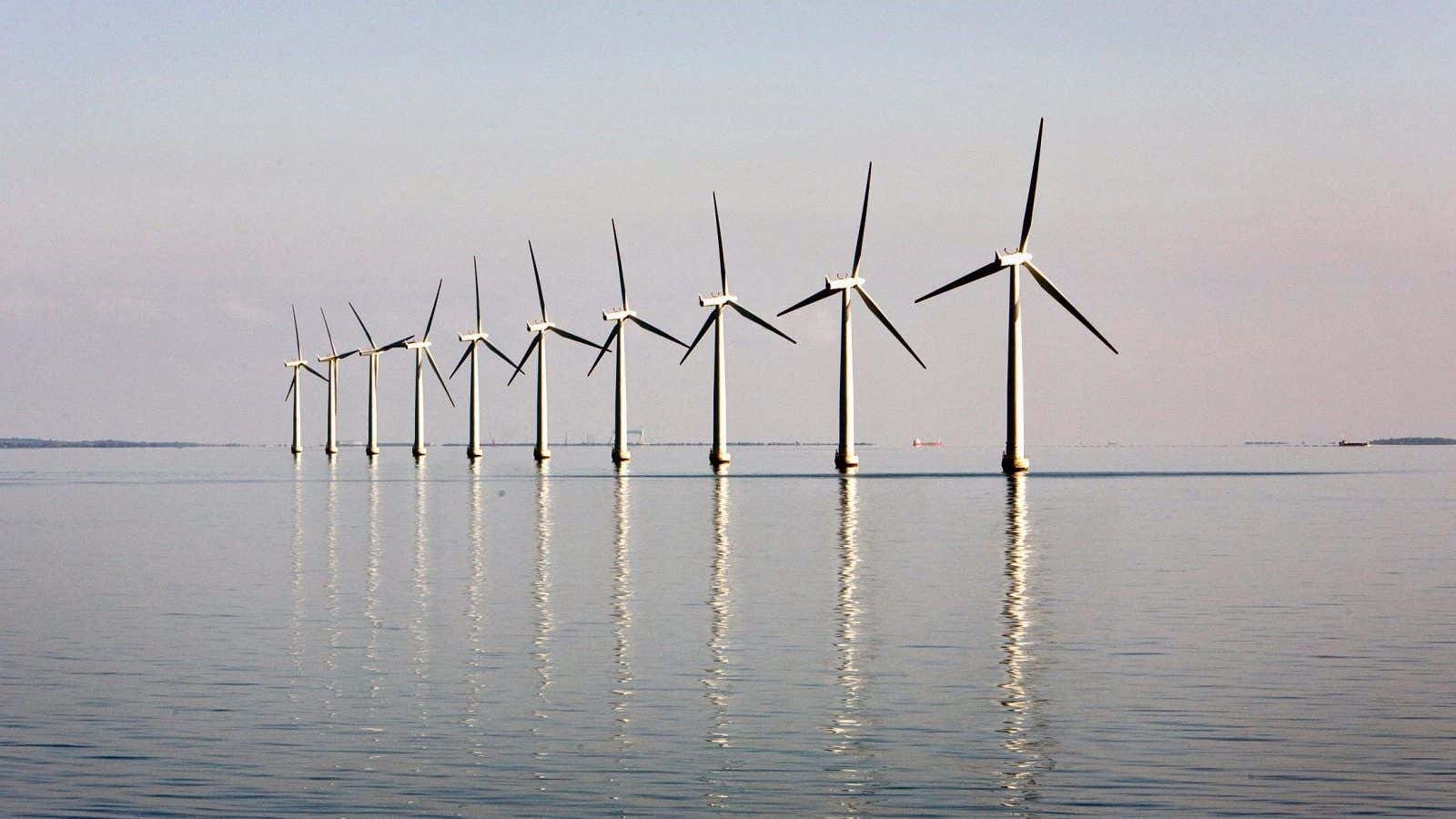India has taken the first major step towards setting up offshore wind power farms.
The government-owned research and development agency, National Institute of Wind Energy (NIWE), has sought expressions of interest (EoI, pdf) from wind power companies to set up an offshore wind farm with a capacity of around 1,000 megawatts (MW) in the Gulf of Khambat, off the coast of Gujarat.
Offshore wind farms refer to windmills installed on the seabed rather than on land. These support larger wind turbines and so generate higher amounts of power. Give their location, these facilities face minimal space constraints and physical obstructions to wind flow.
However, they come with their own set of challenges, like high costs and transmission issues.
India has an estimated 127 gigawatts (GW, or 1,000 MW) of offshore wind power potential, mostly off the coasts of Tamil Nadu, Gujarat, and Maharashtra.
And this initiative comes at a time when the Indian government is going all out to tap renewable energy, targeting a capacity of 175 GW from onshore wind, solar, biomass, and small hydropower by 2022. While offshore wind power doesn’t come under this goal, the Narendra Modi government plans a capacity of 5,000 MW in the segment, too.
Gaining momentum
India’s push for offshore wind power has been gathering momentum in recent years.
For instance, in 2013, the NIWE set up a 100-metre mast in the Rameshwaram town at the southern tip of the Indian peninsula to measure wind speeds in the region. The NIWE has been studying the data and says the “results obtained from the measurement campaign are promising and encouraging.”
In October 2015, the country released its first National Offshore Wind Energy Policy, detailing the government’s roadmap.
More recently, in March 2018, it said it was exploring options to set up a small government-owned offshore wind farm near the Pamban island off the Tamil Nadu coast. The idea is to have four or five windmills with a capacity to generate 6 MW of power each.
Meanwhile, one of India’s largest windmill manufacturers, Suzlon, has set up its own offshore met station off the coast of Gujarat to collect wind data and study the region’s potential.
Multiple headwinds
However, it will be a few years before India can see an offshore wind farm.
The call for EoIs is merely a preliminary step, as the document released by the NIWE doesn’t yet mention details of the project and only talks about a meeting of those interested in the idea.
“The government is pushing for offshore because technology is improving all the time…The 1,000 MW is something that will become commercial maybe four or five years from now,” Ramesh Kymal, CEO of wind turbine maker Siemens Gamesa’s onshore business in India, told Quartz.
Besides, there is no word yet on how the power from offshore farms will be priced. Offshore windmills are more expensive than onshore ones. Power generated from the former could cost around Rs12 per unit, compared to around Rs2.43 for onshore wind power, the cheapest source of renewable energy in India today.
For the proposed Gujarat project, the government is likely to step in with incentives and policies to handhold the sector for a few years, like what was done for the onshore sector in its early days, Kymal said.
“In the European markets, the (offshore wind power) tariffs have come down significantly. So people feel it can come down to a commercially viable level in India, too. Having said that, this (Gulf of Kambhat) is just a pilot project and people are skeptical about its technical feasibility,” said Ankur Agarwal, senior analyst with India Ratings and Research. ”Another major constraint is grid. How do you make transmission lines available?”
Then there are issues with manufacturing or procuring equipment. Offshore wind farms typically have larger turbines of around 6 MW capacity (as against the average of 2.5 MW machines used onshore) and longer windmill blades.
But most firms in India don’t yet make such high-capacity machines, so components will have to be imported.
“The factories’ configuration has to be changed. In terms of logistics, putting larger blades on Indian roads is next to impossible. That’s the reason wind blades on average are smaller in India than in China as the roads are smaller here. This…might dampen investor interest,” said Malolan Cadambi, managing director of Bengaluru-based wind power firm Greenshore Energy.
Nevertheless, the government’s plan will put India in the same league as other countries investing in offshore wind energy. Globally, there’s around 14,300 MW of installed offshore wind energy capacity, 88% of it in European waters and the rest in China, Japan, South Korea, and the US.
“If India is able to do it (achieve the 5,000 MW target), it will be one of the first markets to do so on a large scale,” said Agarwal of India Ratings.
